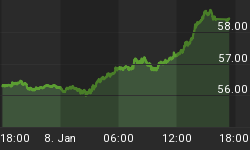The inverse relationship between the real interest rates and gold is relatively well-known among precious metal enthusiasts. Thus, recent Fed rate hike had been widely discussed in this circle many weeks before the hike took place. In a nutshell, gold tends to perform positively in a negative short-term rate environment and vice versa. Recently, this relationship has been demonstrated admirably by
Now, I am going to make a (I think, relatively safe) assumption that negatively short-rate is positive for silver as well.
On the following two observations made by other authors, Fed is likely to keep real interest rate in the negative for the medium-term.
First, ContraryInvestor.com has indicated the historical pattern that in the case of below 80% Capacity Utilization, Fed tightening cycles tend to be shortened.
| Date Of Initial Fed Funds Rate Increase | Capacity Utilization | Months Until Next Fed Funds Rate Peak |
| 11/67 | 87.3% | 21 months |
| 4/71 | 79.2 | 4 |
| 3/72 | 83.1 | 29 |
| 5/76 | 79.1 | 2 |
| 5/77 | 83.9 | 35 |
| 11/86 | 79.1 | 9 |
| 4/88 | 83.7 | 11 |
| 2/94 | 82.1 | 14 |
| 7/99 | 82.3 | 9 |
| Current | 76.5 | ? |
Source: "The Character of Slack" by ContraryInvestor.com
The economy is likely to be too weak for a sustained rate hike cycle. Its fair to speculate that the Fed's tightening policy will result in higher nominal interest rate (to calm down Wall Street) while keeping the real interest rate in the negative.
And the Fed may have a second obstacle in raising real short rate till it's positive. A very weak financial system. On top of major commercial and investment banks' convoluted, unfathomable (and almost two-hundred trillion dollar) derivative position,
It is often believed that if the Fed doesn't tighten, the market will do so. This "free market" tightening seems especially likely considering the current state of American twin deficits financed by foreign central banks' multi-trillion dollar US securities holdings. However, Fed can always evoke its power to keep both long and short-term interest rates low. They can keep the long-term rates low by buying T-bonds. Modern wonders such as digital currency technology will be a lot more inflationary efficient than paper money, which requires logistics of printing press and Milton Freeman's proverbial money-dropping helicopter. It seems to me that Fed purchasing T-bonds involves nothing more than a few accounting entries. If Japanese dump them, we buy them. If Chinese dump them, we buy them too!
Furthermore, election years notwithstanding, inflation, compares to deflation, is always a more politically palatable outcome. This is especially so that the American middle class, where the voting power resides due to its sheer number, is likely to be the most deeply in debt. Inflation favors debtors. Deflation is debtors' nightmare.
In short, the economy is too weak for a rising real rate. And the financial system is even weaker to sustain rising real rate! Fed's rate hikes may make nothing more than the ceremonial posture of fighting inflation; with Fed governors crossing their fingers in hoping Wall Street and the investing public will buy into a low-inflation, stable-growth scenario. This environment fosters bullish fundamentals for precious metals in general, and silver in particular due to its many years of supply deficit. My guess is these medium-term fundamentals are likely to last for several months (and possibly to a year), during which silver and silver stocks can potentially make new highs. Therefore, physical silver and silver stock investors may look forward to rising prices for the next several months.
















